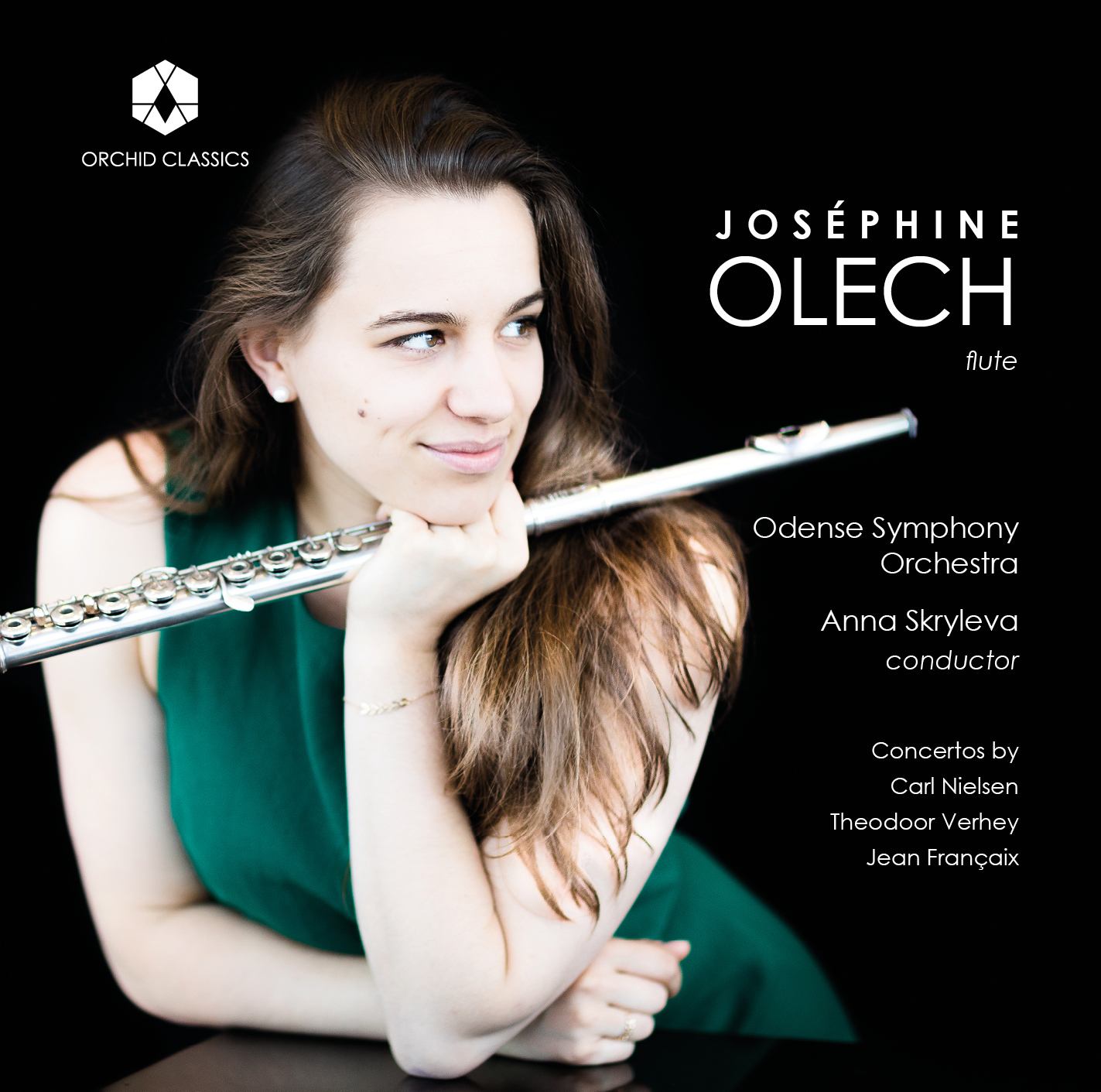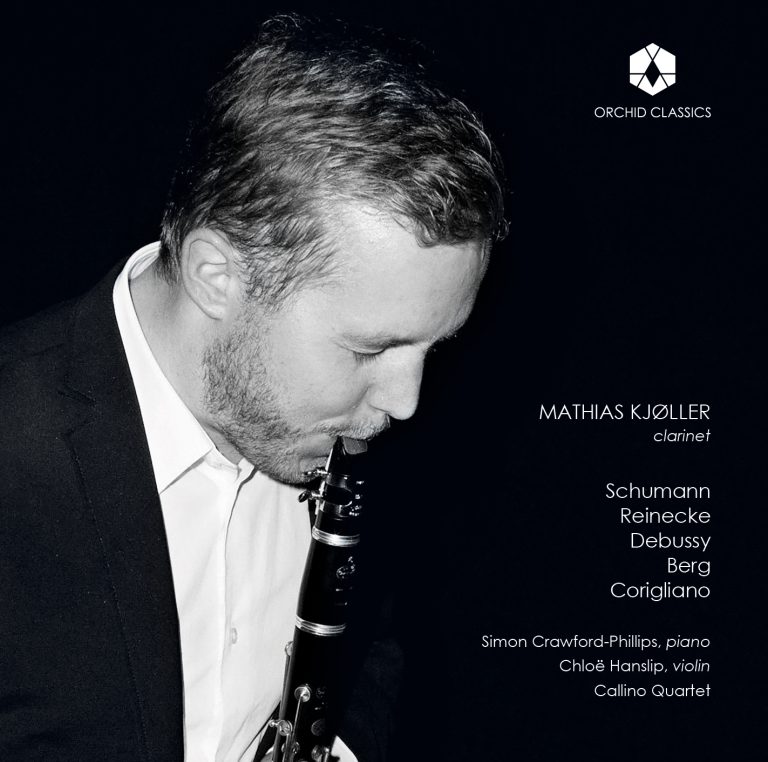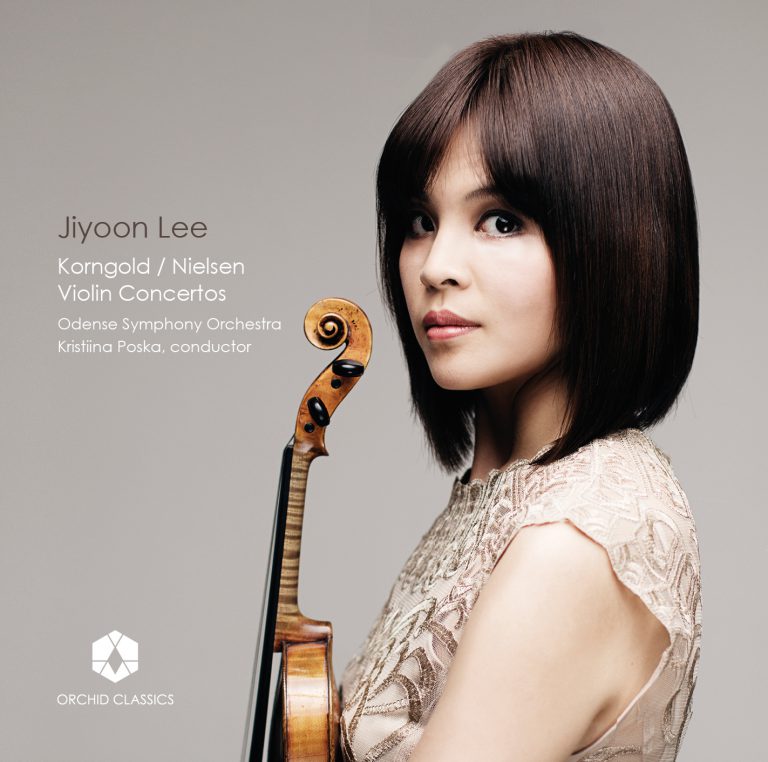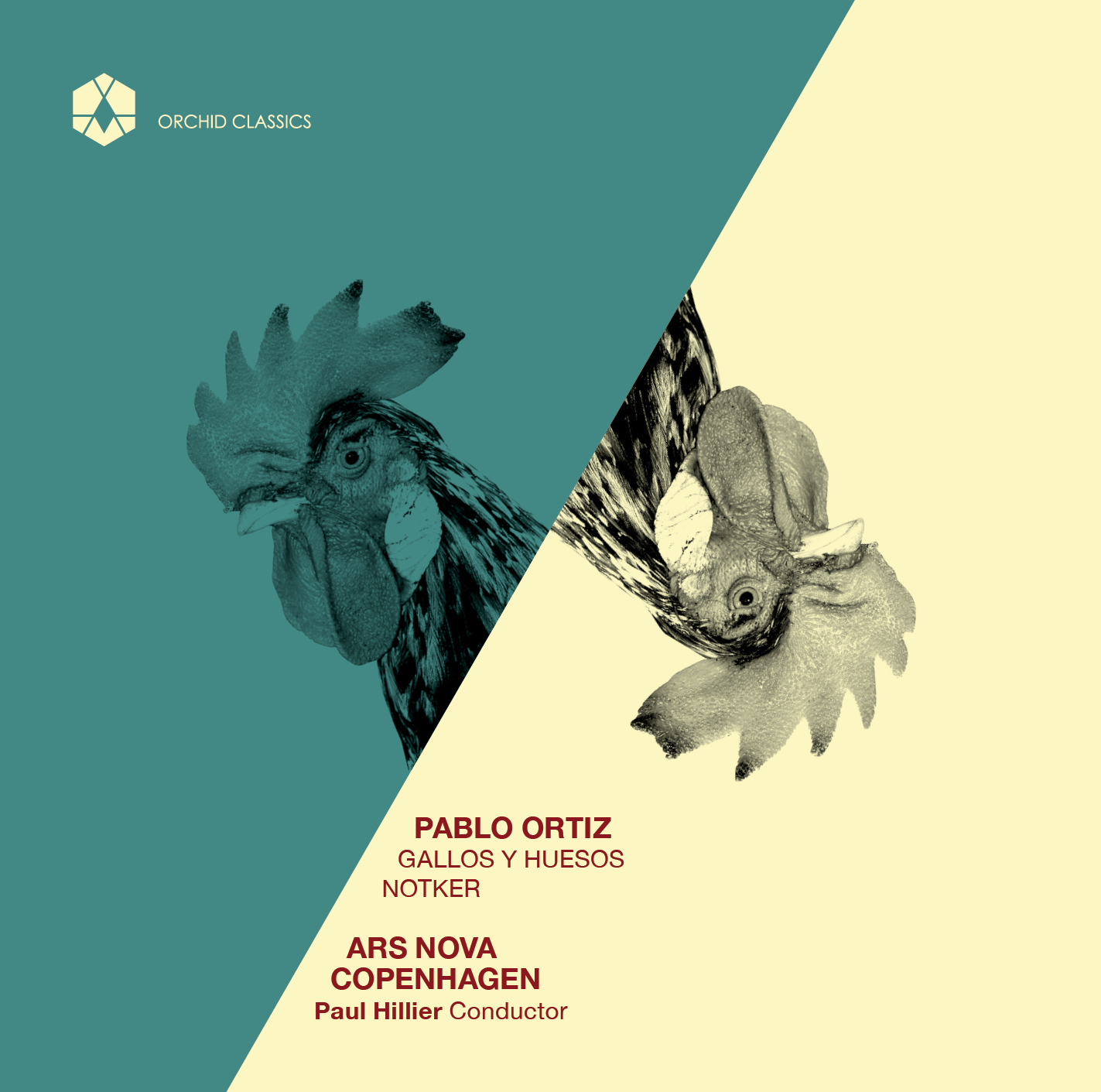Artist Led, Creatively Driven

Joséphine Olech, flute
Concertos by
Nielsen, Verhey & Françaix
Odense Symphony Orchestra
Anna Skryleva, conductor
Release Date: July 9th
ORC100169
Carl Nielsen (1865-1931)
Concerto for flute and orchestra
1. I Allegro Moderato
2. II Allegretto un poco – Adagio ma non troppo
– Tempo di Marcia
Theodoor Verhey (1848-1929)
Concerto for flute and orchestra, Op.43 No.1
3. I Allegro non troppo
4. II Andantino
5. III Allegro alla Zingarese
Jean Françaix (1912-1997)
Concerto for flute and orchestra
6. I Presto
7. II Andantino
8. III Scherzo
9. IV Allegro – Allegretto con spirito molto
Total time 58.16
Joséphine Olech, flute
Odense Symphony Orchestra
Anna Skryleva, conductor
With this album, I have the wish to explore some less known flute works, as well as to pay a tribute to the three countries which have forged my musical personality so far.
The first country is France, where I was born and raised, and where I learned to play flute with teachers who descend directly from the French Woodwinds tradition. Jean Françaix is known for his compositions for woodwinds, but his flute concerto is very rarely played, even though it represents very well this French school of playing, focused on virtuosity, flexibility of sound and articulation.
The second country is the Netherlands, and particularly the city of Rotterdam, where I live and work and which I now call my home. Theodoor Verhey is a Dutch composer who taught in the Rotterdam conservatory. His work is very much inspired by the works of Robert and Clara Schumann, and Johannes Brahms. I fell in love with his flute concerto in D minor for its passionate outbreaks as well as for its intimate melodies: it is a very nice addition to the flute romantic repertoire.
And last but not least, the third country is Denmark, in particular the city of Odense, birthplace of the composer Carl Nielsen, and host city for the Nielsen International Competition which I won in 2019. The flute concerto by Carl Nielsen is a crucial piece of the flute repertoire, and I feel extremely privileged to have been able to play it with the wonderful musicians of the Odense Symphony Orchestra. It is truly a wonderful piece; the musical language of Carl Nielsen is one of a kind, and it took time for me to understand it as a student, but I have grown absolutely fond of it and I am sure I will continue discovering many more of its aspects with time.
It has been such an honour and pleasure to be able to record this album with the great Anna Skryleva and the Odense Symphony Orchestra, and with Mette Due and Prebben Iwan as artistic directors. I thank all of these wonderful artists truly, and I hope you will enjoy listening to this album as much as we enjoyed making it.
Joséphine Olech
The Danish composer Carl Nielsen (1865-1931) completed three concertos, for violin, flute and clarinet. He had intended to write concertos for each member of the Copenhagen Wind Quintet after hearing the group performing Mozart in 1921, but only managed the two. His own Wind Quintet was composed in 1922, the Flute Concerto in 1926 for the quintet’s particular, even pedantic flautist, Holger Gilbert-Jespersen, and the Clarinet Concerto in 1928.
This flurry of activity came relatively late in Nielsen’s life, and the Flute Concerto was his first major work following the completion of his Sixth (and final) Symphony. It was composed in the aftermath of a spell of poor health that had hindered the composer for much of 1926. In August of that year, he rallied sufficiently to travel to Munich as part of a group of advisors testing the installation of a new Danish radio mast there. Nielsen brought the manuscript of the Concerto with him and worked on it in Munich, and during subsequent trips to Florence and Tuscany. He was laid low again in September and had to hurry through a temporary conclusion for the work’s premiere on 21 October in Paris, where it was conducted by his son-in-law, Emil Telmányi. Even in its unfinished state, the Concerto was so well received that it was performed again in the same curtailed form in November, in Oslo, with the composer conducting. At last, in January 1927, Nielsen was able to unveil the finished product for a performance in Copenhagen.
Nielsen argued that “the flute cannot deny its own nature, its home is in Arcadia, and it prefers pastoral moods. Hence, the composer has to follow the mild character of the instrument if he did not want to run the risk of being called a barbarian”. Accordingly, Nielsen’s Flute Concerto is full of pastoral writing for the soloist, contrasted with its polar opposite, the bass trombone, with whom the flute tussles throughout. Yet there is little hint of this “mild character” in the curt, dissonant orchestral introduction after which, as Nielsen put it, “the solo instrument moves about as if seeking something, until it takes hold of a more decisive motive”. There is an ongoing conflict between the key areas of D minor and E flat, tempered by the flute’s lyrical material, which leads us into a gentle secondary theme. When the bass trombone, punctuated by timpani, emerges, the flute responds as though affronted before asserting its dominance with an expansive melody and three brief cadenzas, the last of which also features the clarinet and bassoon. The movement ends in a remarkably lush, Romantic spirit.
The second-movement Allegretto contrasts jutting orchestral passages with more fluid passages for the flute, softening to a wistful Adagio ma non troppo melody. These elements are reprised before Nielsen transforms them into an increasingly agitated march, after which the bass trombone returns, humorously revealing the relationship between the flute’s melodies in both movements. What could have been an ostentatious display of structural unity becomes a moment of bathos. The bass trombone finally settles us in the key of E flat and proceeds to interrupt the last bars with raucous glissandi, its brash tones providing an earthy backdrop to the flute’s gleaming triumph.
Theodoor Verhey (1848-1929) was a Dutch composer and pianist who studied in Rotterdam and The Hague before taking lessons with Woldemar Bargiel, Clara Schumann’s stepbrother. His connection with the world of the Schumanns and Brahms was reinforced via the clarinettist Richard Mühlfeld, by whom Verhey, in common with many other composers of the era – especially Brahms – was inspired. But it is for his two Flute Concertos that Verhey is today remembered; much of the remainder of his output has never been recorded. The Flute Concerto No.1 in D minor, Op.43 dates from 1902 and is dedicated to Ary van Leeuwen, a flautist born in Arnheim whose career included playing for the Berlin Philharmonic and Philadelphia Orchestras, and who in 1903 was invited by Mahler to teach and perform in Vienna.
The work opens with an orchestral introduction that foreshadows the tightly ornamented nature of the flute part, which is characterised by rapid arpeggaic and scalic figures connecting soaring phrases. Verhey’s virtuoso flute writing has much in common with that of the Concertino by Cécile Chaminade, composed in the same year. The romantic central Andantino exploits the instrument’s lyrical properties, and a fiendishly demanding finale, alla Zingarese, draws on the Hungarian folk styles of which Brahms was also particularly fond.
Jean Françaix (1912-1997) was born into a musical family in north-west France, and as a young man his musical talents were recognised by Ravel, who wrote to Françaix’s father: “Among the child’s gifts I observe above all the most fruitful an artist can possess, that of curiosity: you must not stifle these precious gifts now or ever, or risk letting this young sensibility wither.” Another composer, Marcelle de Manziarly, put Françaix in touch with the composition teacher Nadia Boulanger, who gave Françaix lessons and who later conducted or played several premieres of his works.
The influence of Emmanuel Chabrier is palpable in Françaix’s music; he favoured urbane neoclassicism rather than atonality, emphasising his desire “to give pleasure … to do something that can be called ‘Français’, with both an S and an X, that is, to be jolly most of the time – even comical… To avoid the premeditated wrong note and boredom like the plague.” His friend Poulenc praised his music as being “full of lightness and poetical insight”. Even so, Françaix’s music was for a while more popular in Germany than in his native France. As he reflected in 1981: “my music has not been played by French orchestras in almost ten years… With Berlioz and Debussy it was because the music was not understood. Mine is too easily understood.”
On the other hand, Françaix’s idiomatic and substantial output for the flute was embraced by flautists in France and elsewhere, leading to a number of commissions for the instrument. Françaix dedicated his Divertimento for flute and piano (1953, orchestrated 1974) to the great French flautist Jean-Pierre Rampal, who also gave the premiere of the Flute Concerto (1966). Rampal once declared that “there is not much modern music that touches me. I will play only contemporary works that make sense to my heart”, so it was testament to Françaix’s skill and immediacy of style that Rampal embraced his Concerto.
One attribute of Françaix’s neoclassicism is the employment of connecting cyclical forms, as used by Franck, Debussy and Ravel. This technique, in which thematic material recurs and evolves, is a feature of the Flute Concerto. The work opens with a debonair Presto that is literally breath-taking, its quick, mercurial flute part unfolding as though in conversation with the orchestra, with an elaborate central cadenza. The Andantino is more mysterious, starting with a languid flute melody played out over whispering strings. The music grows in animation, leading to another cadenza before returning to the opening sonority, when other woodwinds take up the theme, decorated by the flute. The final Scherzo opens with an orchestral crescendo that launches a dazzling flute part. There is very little let-up for the soloist throughout: virtuosity gives way to long-breathed phrases as the flute duets with a solo violin before the non-stop pace of the opening returns. The work ends with witty levity, encapsulating Francaix’s philosophy: “I wish to be honest: when I am composing, the finest theories are the last things that come to mind. My interest is not primarily attracted by the ‘motorways of thought’, but more the ‘paths through the woods”.
© Joanna Wyld, 2021
French flautist, Joséphine Olech, praised for her “subtle elegance” and “luminous joy” by Bachtrack, enjoys a busy career as a soloist, chamber musician, and orchestral musician. Appointed principal flute of the Rotterdam Philharmonic Orchestra in 2017, she has since solidified her place as an eminent young artist by winning the First Prize, Audience Prize, and Junior Jury Prize at the Carl Nielsen International Competition in 2019, as well as the Fanny Mendelssohn Förderpreis in 2020.
As the 2020 winner of the Fanny Mendelssohn Förderpreis, she was able to record her debut album « Reconnect-Nature and the Modern Man », released in December 2020 by the label C2-Hamburg.
In May 2021 she performed the world premiere of Thierry Escaich’s new flute concerto in the Royal Concertgebouw Amsterdam, with the Rotterdam Philharmonic under the direction of Lahav Shani.
Winner of the third prize at the Prague Spring International Competition (2015), Joséphine has been invited to appear as a soloist with the Royal Stockholm Philharmonic, Magdeburgische Philharmonie, Domestica Rotterdam, and Kuopio Symphonic Orchestra among others. As a testament to her talent, Révélation Classique ADAMI nominated her to their 2018 young artist roster in France.
As principal flute of the Rotterdam Philharmonic Orchestra, Joséphine plays regularly under the baton of such conductors as Lahav Shani, Yannick Nézet-Seguin, and Valery Gergiev. With the RPHO, she has performed in many of the great halls of Europe including the Elbphilharmonie Hamburg, the Berlin Philharmonie and La Scala in Milan.
Anna Skryleva has worked in some of Germany’s most distinguished opera houses and from the 2019/20 Season takes up the position of General Music Director at Theater Magdeburg.
From 2013-15, Anna was First Kapellmeister at the Staatstheater Darmstadt where she made her debut conducting Strauss’s Salome. She previously held the same position at the Staatstheater Schleswig-Holstein, where her interpretation of Weber’s Der Freischütz met with critical acclaim.
Anna has been employed on the music staff of both the Cologne Opera and the Staatsoper Hamburg. She worked as first assistant conductor for landmark productions of Wagner’s Der Ring des Nibelungen at both companies, where she collaborated closely with music directors Markus Stenz and Simone Young. In Hamburg, Anna conducted main-stage performances including Lehar’s The Merry Widow, Humperdinck’s Hänsel und Gretel and Rossini’s Il turco in Italia.
As a guest conductor, Anna has appeared at houses including the Dallas Opera and the Hessian State Theater, Wiesbaden. In the season 2019/2020 she makes her debut at The Royal Swedish Opera Stockholm with Mozart’s The Magic Flute and Tchaikovsky’s The Nutcracker.
Anna Skryleva is under great demand on the concert stage, working with the Frankfurt Radio Symphony Orchestra, the Aarhus Sinfonieorchester and Copenhagen Philharmonic, the South German Philharmonic Konstanz, the North German Philharmonic Rostock, the Orquesta Filarmónica de la UNAM in Mexico City and debuts with the Deutsches Sinfonie Orchester Berlin in March 2020.
She is an experienced ballet conductor and has worked with dance companies including New York’s Paul Taylor Dance Company.
Anna’s operatic repertoire ranges from the Viennese classics through to German and Russian Romantics, the Italian bel canto school, and staple works of the twentieth century and beyond. She has conducted works by composers from Wagner to Kurt Weill, from Rossini to John Adams.
Anna was named Person of the Year in 2013 by the arts section of the Main-Echo newspaper. In 2014, she founded the international peace initiative Classics for Peace, which immediately met with widespread support from both the public and from high-ranking politicians, including the Hessian State President Volker Bouffier.
Anna was raised in Moscow, where she studied piano and composition at the Moscow State Tchaikovsky Conservatory. She later studied at the University of Fine Arts in Berlin. She signed to Nordic Artists Management in 2018.
The Odense Symphony Orchestra – one of Denmark’s five regional orchestras – was established in 1946, but its roots go all the way back to about the year 1800. From being a theatre orchestra that also played symphonic music, the orchestra today is continuously developing and expanding its modern symphony orchestra with 72 permanent musicians and a high level of activity. Concerts and productions with Odense Symphony Orchestra vary in terms of size and genre: from symphony concerts, light classical and opera to chamber music, children/youth concerts and crossover.
Odense Symphony Orchestra is the owner and host of Carl Nielsen International Competition, and the orchestra and its musicians play an important role in the competition as jury members, repertoire consultants and contact persons to many international artists.
The first of the Carl Nielsen International Competitions was held in Odense in 1980. After nearly four decades, the violin, clarinet and flute competitions have established themselves as some of the most demanding and rewarding in the world, by highlighting Carl Nielsen’s musical masterpieces, and offering each winner the chance to launch a significant international career.
For more information on Carl Nielsen International Competition please visit
www.carlnielseninternationalcompetition.com.










